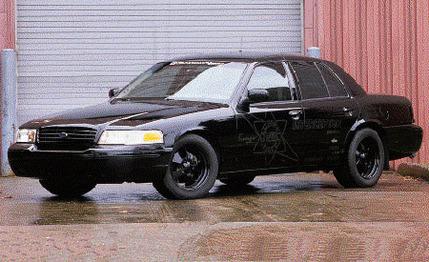
 Specialty File
Specialty File
Apart from its role in grills, camping lamps, and hot-air balloons, propane is one of various alternative fuels being used in vehicles to reduce exhaust emissions. The Ford Motor Company, no less, already offers a propane/gasoline flexible-fuel F-series light-duty pickup truck. Still, propane hasn't been in the headlines nearly as much as, say, compressed natural gas, or even hydrogen.
That's mainly because propane companies haven't been that aggressive in promoting their product as an alternative fuel. Scott Alder, of Scott Alder Motorsports in Redondo Beach, California, thinks that's about to change. For one thing, propane is not an imported fuel. We make our own. For another, it works well. To demonstrate the advantages of a propane-fueled vehicle, Alder brought along a V-10- powered Ford Crown Vic Police Interceptor and let us test it.
Why a police car? Well, primarily because agencies monitoring air quality in various locations nationwide are pressing for cleaner vehicles serving airports, and some offer quite enticing inducements for those operators purchasing clean-air vehicles. Since many taxicabs are rehabilitated cop cars, Alder figured it was smart to start at the top of the chain.
For kicks, he pulled the original 4.6-liter V-8 out of this 1999 Interceptor and dropped in a 6.8-liter V-10 and transmission originally intended for a Ford F-series pickup. F-series trucks use both V-8 and V-10 engines, so the engine mounts were pretty much where they needed to be in the Interceptor.
The big truck transmission didn't fit quite that easily. It was necessary to cut and reshape the Interceptor's cowl, as well as relocate and fabricate new transmission mounts. The car's original aluminum driveshaft had to be shortened to fit, but it turns out that's a good thing, since some originals have had high-speed vibration problems that shortening may cure.
To convert the engine to propane, Alder's guys deep-sixed the original fuel tank and evaporation canister and replaced them with a propane tank supplied by Thiokol Propulsion (it holds the gas equivalent of 21 gallons at a comparatively low pressure of about 300 psi). A Corvette fuel pump resides in the tank to pressurize the supply line. The installation leaves trunk capacity and rear-seat space completely unaffected.
New fuel lines were fitted, along with a new fuel rail and injectors from Bi-Phase Technologies of Lake Lillian, Minnesota. As propane actually has a higher calorific value than gasoline, its stoichiometric ratio-the ideal air-fuel mixture-is 15.7:1 versus gasoline's at 14.7:1. The smaller injectors obviate the need for any change to the car's stock powertrain controller. And with an octane value of 104, propane is ideal for high-compression engines.
Because the car's fuel-injection system operates with liquid propane, the car requires a so-called distribution block to recirculate the propane to purge vapor. In most vehicles, the dome-light switch could activate this as the driver opens the door, readying the car for an immediate start.
Since Alder's car is a police vehicle, it lacks this dome-light switch, so you need to wait briefly after the ignition is switched on before twisting the key to start the engine. Thereupon, the propane-fueled Ford runs as one might expect a V-10-powered Interceptor to run-that is, strongly, reaching 60 mph from rest in just 6.6 seconds and dispatching the quarter-mile in 15.2 seconds at 92 mph. The numbers on our last 4.6-liter police Vic: 8.4 to 60 and 16.5 at 84 mph in the quarter.
Alder's Interceptor wafts from 30 to 50 mph in just three seconds, including kickdown delay, and the torque from the truck motor hefts this big car around with a deceptively lazy demeanor. With an eye to the enthusiast market, Alder also equipped the car with aftermarket springs, monotube Bilstein shocks, custom brake rotors with carbon-metallic pads, and 10.0-by-17-inch alloy wheels with BFGoodrich g-Force T/A rubber.
As a result, the Alder car pulled 0.88 g on the skidpad and circulated the Streets of Willow road course in a manner that suggested it would make a pretty cool patrol car, particularly once the tired limited-slip diff was tightened up and the stock seats ditched in favor of furniture with more support.
As with all alternative-fuel vehicles, the drawback with a propane-powered car is the relative lack of refueling infrastructure. Yet U-Haul and other rental depots can supply fuel, and most can even collect the small tax currently levied on propane that is used as vehicle fuel. The upside is that the actual unit price is substantially lower per gallon equivalent than gasoline's.
Alder had a propane tanker come to the test track, and it refueled the Interceptor in about the same time it would take to fill up a normal vehicle at a gas station. In some municipalities, SULEV-compliant vehicles are allowed in high-occupancy lanes, and easy commuting may well offset any hassles encountered finding fuel during cross-country trips.
Best of all, though, is the fact that this car qualifies as an environmentally friendly vehicle while performing, responding, and sounding like the high-performance cars that got us hooked on this hobby in the first place. l
Scott Alder Motorsports, 18225 Kingsdale, Redondo Beach, California 90278; 310- 345-2427; www.samotorsports.com.